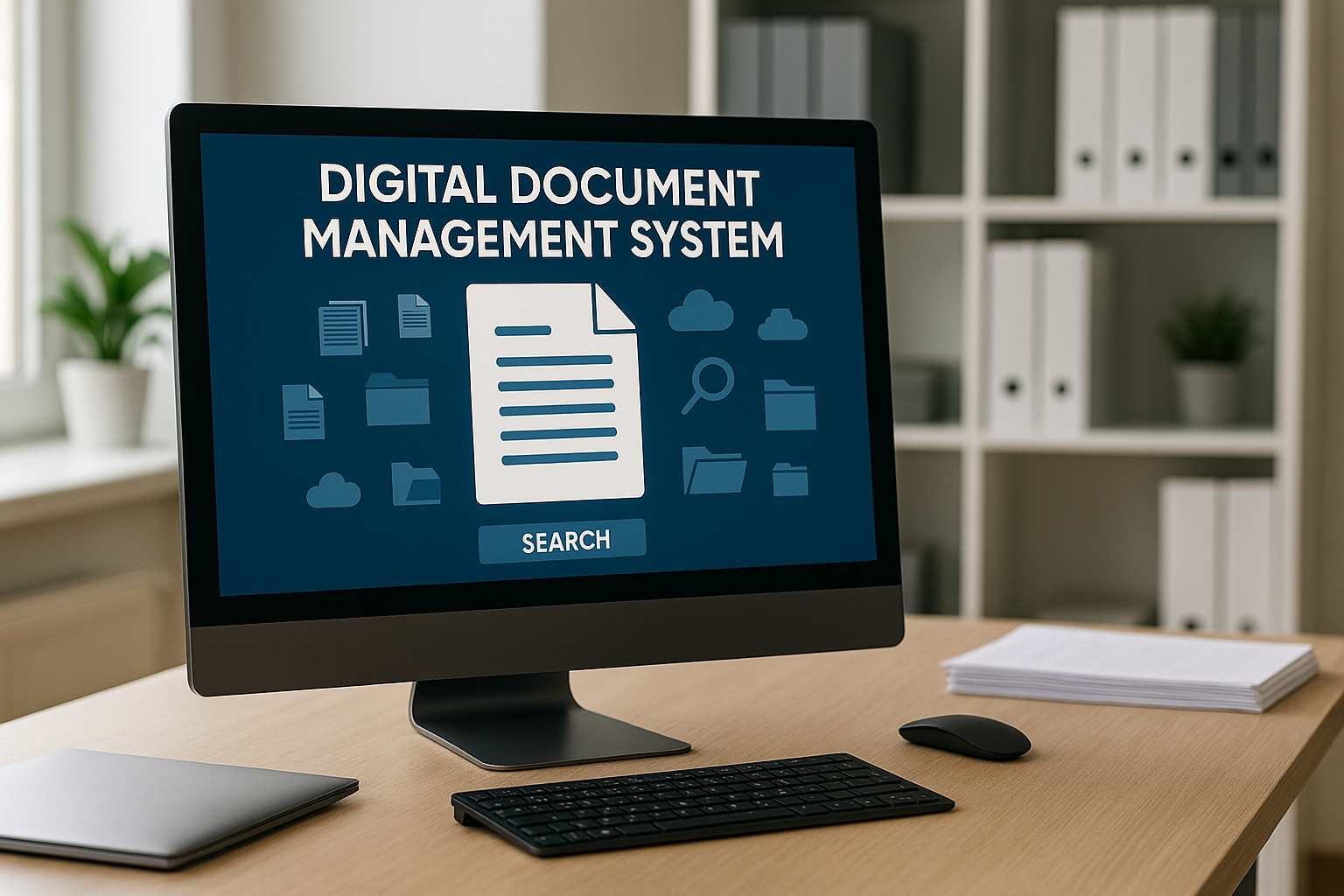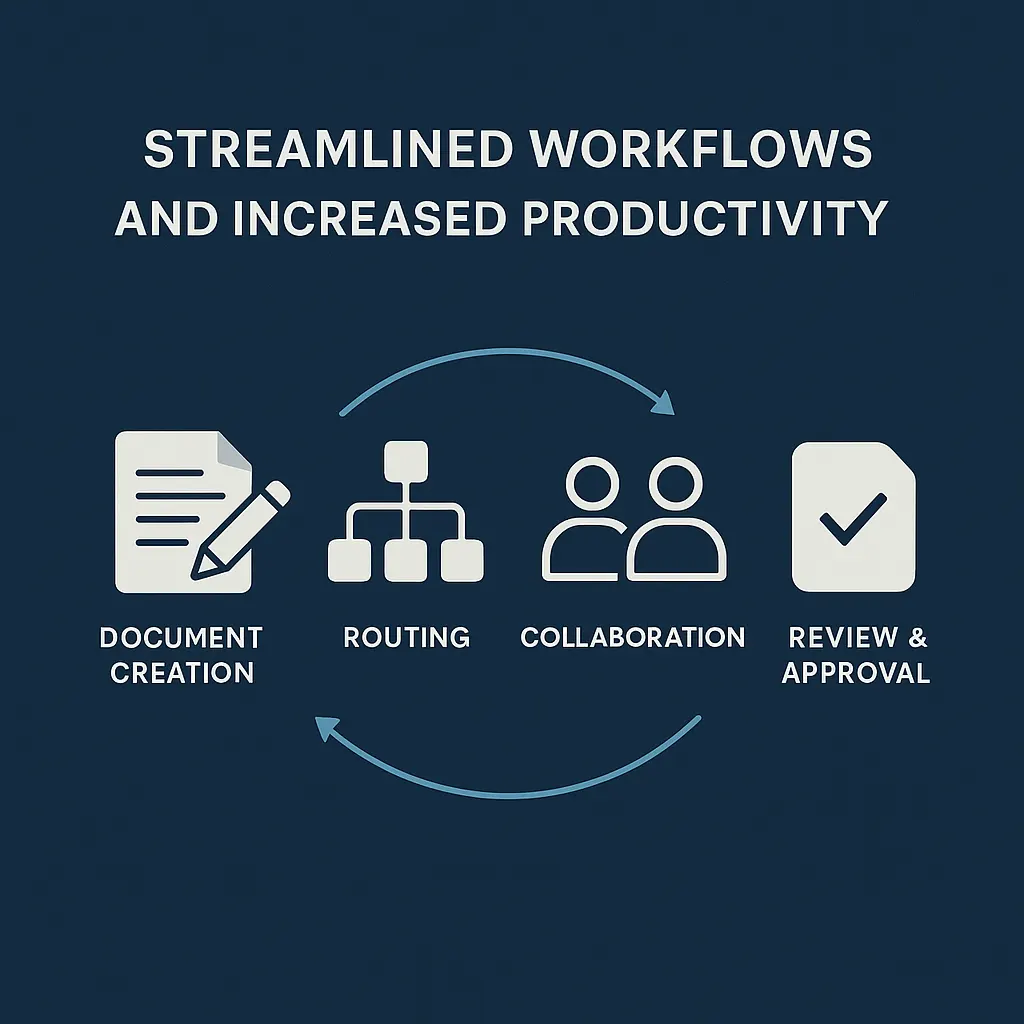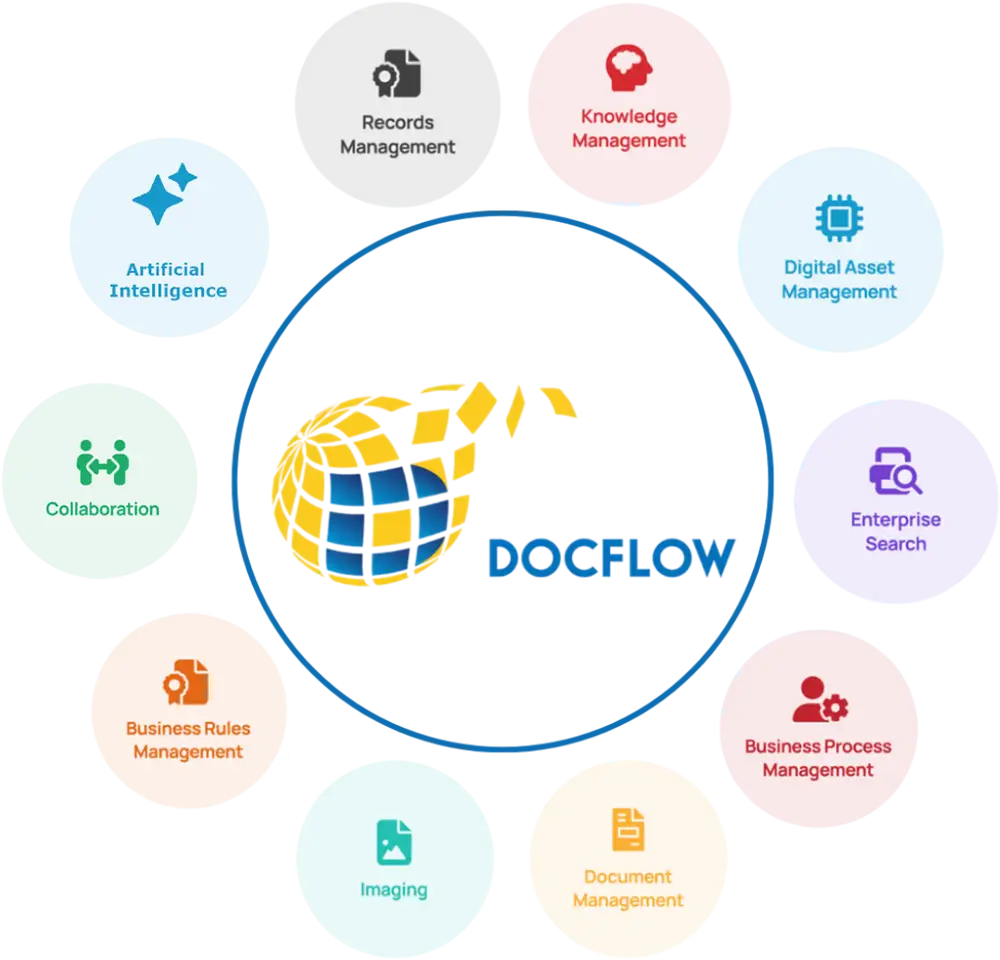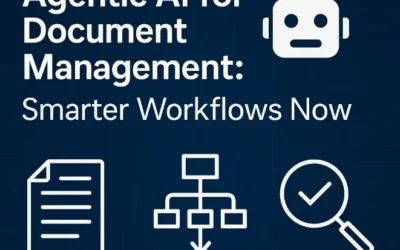In today’s fast-paced business environment, managing the ever-growing volume of documents efficiently has become crucial for operational success. A Digital Document Management System (DDMS) offers a comprehensive solution to organise, store, and track your business documents while enhancing collaboration and ensuring compliance. With 83% of organisations reporting significant productivity improvements after implementing a DDMS, according to recent 2023 industry data, the question isn’t whether your business needs such a system—but rather which solution best fits your unique requirements.

What Is a Digital Document Management System?
A Digital Document Management System (DDMS) is a software solution designed to capture, store, manage, and track electronic documents and digital images of paper-based information. Unlike simple file storage systems, a DDMS provides sophisticated features for document organisation, retrieval, security, and workflow automation.
Modern DDMS solutions have evolved from basic electronic filing cabinets into comprehensive platforms that integrate with your existing business applications, automate document-centric processes, and facilitate seamless collaboration across teams—regardless of their physical location.
- Document Capture and Import: Scanning physical documents, importing electronic files, and extracting data through OCR (Optical Character Recognition) technology
- Document Storage and Organisation: Centralised repository with customisable folder structures, metadata tagging, and version control
- Search and Retrieval: Advanced search capabilities using keywords, metadata, content, and filters
- Access Control and Security: Role-based permissions, audit trails, and document encryption
- Workflow Automation: Configurable approval processes, task assignments, and notifications
- Collaboration Tools: Real-time document editing, commenting, and sharing capabilities
- Integration Capabilities: Seamless connection with other business systems like CRM, ERP, and productivity suites
- Compliance Management: Records retention, regulatory compliance features, and audit support
Ready to streamline your document management?
Discover how a modern Digital Document Management System can transform your business operations.
5 Key Benefits of Adopting a Digital Document Management System
Implementing a Digital Document Management System delivers tangible benefits across multiple aspects of your business operations. According to a 2023 survey by Document Strategy Forum, organisations that adopted a DDMS reported an average 35% reduction in document processing time and a 42% decrease in document-related errors.

1. Significant Cost Savings
A Digital Document Management System dramatically reduces expenses associated with physical document management. According to recent studies, businesses spend approximately £20 in labor to file a document, £120 to find a misfiled document, and £220 to reproduce a lost document. By eliminating these inefficiencies, companies implementing DDMS solutions in 2023 reported average cost savings of 40% in document-related expenses.
2. Enhanced Security and Compliance
With data breaches costing companies an average of $4.45 million in 2023 (IBM Security Report), document security has never been more critical. A robust Digital Document Management System provides:
- Granular access controls that restrict document visibility based on user roles
- Comprehensive audit trails that track all document activities
- Automated retention policies that ensure compliance with industry regulations
- Advanced encryption that protects sensitive information
- Disaster recovery capabilities that safeguard against data loss
In regulated industries like healthcare, finance, and legal services, DDMS solutions provide essential tools for maintaining compliance with HIPAA, GDPR, SOX, and other regulatory frameworks.

3. Improved Accessibility and Remote Work Support
The shift toward hybrid work environments has made document accessibility a top priority. A 2024 Gartner report found that 74% of companies plan to maintain or increase remote work options, making Digital Document Management Systems essential infrastructure. Modern DDMS solutions enable:
- Secure access to documents from any location and device
- Real-time collaboration regardless of team members’ physical locations
- Mobile-friendly interfaces for on-the-go document management
- Offline access capabilities with automatic synchronisation
- Consistent document availability during business disruptions
- Streamlined approval processes across distributed teams
4. Streamlined Workflows and Increased Productivity
Workflow automation is a cornerstone feature of modern Digital Document Management Systems. By automating routine document processes, businesses have reported productivity gains of up to 30% according to AIIM’s 2023 State of the Industry report. Key workflow improvements include:

- Automated routing of documents to appropriate stakeholders
- Configurable approval chains with notification systems
- Status tracking for documents in process
- Elimination of bottlenecks through parallel processing
- Integration with existing business processes and systems
5. Environmental Sustainability
Sustainability has become a core business value, with 78% of consumers more likely to purchase from environmentally responsible companies (Nielsen, 2023). A Digital Document Management System significantly reduces paper consumption, contributing to:
- Reduced carbon footprint through decreased paper usage
- Lower energy consumption compared to maintaining physical storage
- Minimised waste from printing, copying, and disposing of documents
- Alignment with corporate sustainability initiatives

Experience these benefits in your organisation
Join the 73% of companies reporting improved workflows after implementing a Digital Document Management System.
Comparing 3 Types of Digital Document Management System Solutions
When evaluating Digital Document Management System options, organisations typically choose between three deployment models: cloud-based, on-premise, and hybrid solutions. Each approach offers distinct advantages and considerations based on your specific business requirements.
Cloud-Based DDMS Solutions
| Advantages |
|---|
| Lower initial investment with subscription-based pricing |
| Automatic updates and maintenance handled by the provider |
| Rapid deployment with minimal IT infrastructure requirements |
| Seamless remote access from any location with internet connectivity |
| Scalable storage that grows with your business needs |
| Built-in disaster recovery and redundancy |
| Considerations |
|---|
| Ongoing subscription costs may exceed on-premise costs long-term |
| Potential concerns about data sovereignty and security |
| Limited customisation options compared to on-premise solutions |
| Dependency on internet connectivity and provider uptime |
| Possible compliance challenges in highly regulated industries |
According to a 2023 Forrester report, 67% of businesses now prefer cloud-based document management solutions due to their accessibility, scalability, and reduced IT burden.
On-Premise DDMS Solutions
| Advantages |
|---|
| Complete control over data security and storage infrastructure |
| One-time licensing cost rather than ongoing subscriptions |
| Extensive customisation possibilities to match specific workflows |
| Independence from internet connectivity for core functions |
| Potentially easier compliance with strict regulatory requirements |
| No reliance on third-party service providers |
| Considerations |
|---|
| Higher initial investment in hardware, software, and implementation |
| Responsibility for maintenance, updates, and security patches |
| Additional IT resources required for management and support |
| Limited remote accessibility without additional configuration |
| Scalability challenges requiring hardware upgrades |
| Self-managed disaster recovery and redundancy |
Hybrid DDMS Solutions
Hybrid solutions have gained significant traction in 2023-2024, with 58% of enterprises adopting this approach to balance security, compliance, and accessibility requirements (IDC Document Solutions Survey, 2023).
| Advantages |
|---|
| Flexibility to keep sensitive documents on-premise while leveraging cloud benefits |
| Balanced approach to security, accessibility, and cost |
| Phased migration path from legacy systems to cloud infrastructure |
| Improved disaster recovery through distributed storage |
| Adaptability to changing business requirements |
| Optimised performance for different document types and access patterns |
| Considerations |
|---|
| More complex implementation and integration requirements |
| Potential challenges in maintaining consistent user experience |
| Need for expertise in both on-premise and cloud technologies |
| Additional security considerations for data moving between environments |
| More sophisticated license management and cost tracking |
Not sure which solution is right for you?
Our experts can help you evaluate your options and find the perfect fit for your organisation’s needs.
Real-World Examples: Industries Transformed by Digital Document Management Systems
Across various sectors, organisations are leveraging Digital Document Management Systems to overcome unique challenges and achieve remarkable efficiency gains. Here are some compelling examples from different industries:

Healthcare: Enhancing Patient Care Through Efficient Record Management
Healthcare providers face strict regulatory requirements while managing vast amounts of sensitive patient information. By implementing Digital Document Management Systems, medical facilities have achieved:
- Streamlined patient record access: Physicians can instantly retrieve complete patient histories, improving diagnostic accuracy and treatment decisions
- Enhanced HIPAA compliance: Automated access controls and audit trails ensure patient data privacy and regulatory adherence
- Reduced administrative burden: Staff spend 30% less time on paperwork, allowing more focus on patient care
- Improved care coordination: Seamless sharing of records between departments and specialists enhances collaborative care
Case Study: Memorial Healthcare System implemented a comprehensive Digital Document Management System in 2023, resulting in a 42% reduction in chart retrieval time and a 27% decrease in documentation errors.
Legal Services: Transforming Case Management and Client Service
Law firms manage extensive case files, contracts, and court documents that require meticulous organisation and security. Digital Document Management Systems have revolutionised legal practice by providing:

- Centralised case file management: All case-related documents are organised in a single, searchable repository
- Secure client portals: Clients can safely access and review relevant documents
- Advanced search capabilities: Attorneys can quickly locate precedents and relevant case law
- Automated document assembly: Template-based generation of standard legal documents saves time
- Chain of custody tracking: Complete audit trails ensure document integrity for court submissions
Case Study: A leading corporate law firm reported 35% faster contract review cycles and a 40% reduction in document preparation time after implementing a specialised legal DDMS in 2023.
Financial Services: Ensuring Compliance While Improving Customer Experience
Banks, insurance companies, and investment firms handle sensitive financial information under strict regulatory oversight. Digital Document Management Systems help these organisations:
- Maintain regulatory compliance: Automated retention policies and audit trails satisfy SEC, FINRA, and other requirements
- Accelerate loan processing: Automated document workflows reduce approval times by up to 50%
- Enhance fraud detection: Advanced document verification tools help identify suspicious applications
- Improve customer onboarding: Digital forms and e-signature capabilities streamline account opening
- Support remote banking services: Secure document access enables comprehensive virtual customer service

Case Study: A regional bank implemented a Digital Document Management System for loan processing in 2024, reducing application-to-approval time from 7 days to just 36 hours while improving compliance documentation by 45%.
Manufacturing: Streamlining Operations and Quality Management
Manufacturing companies manage complex documentation for product specifications, quality control, and regulatory compliance. Digital Document Management Systems deliver significant benefits:
- Centralised technical documentation: Easy access to current product specifications and manufacturing instructions
- Streamlined quality management: Automated workflows for inspection reports and non-conformance documentation
- Enhanced supplier collaboration: Secure sharing of specifications and requirements with vendors
- Improved compliance documentation: Comprehensive records for ISO, FDA, and other regulatory requirements
- Efficient change management: Controlled processes for updating and approving engineering changes
Case Study: An automotive parts manufacturer implemented a Digital Document Management System in 2023, reducing document retrieval time by 65% and cutting quality documentation costs by 28%.
See how a DDMS can transform your industry
Discover industry-specific solutions tailored to your unique business challenges.
Choosing the Right Digital Document Management System: Essential Checklist
Selecting the optimal Digital Document Management System requires careful evaluation of your organisation’s specific needs and objectives. Use this comprehensive checklist to guide your decision-making process and ensure you choose a solution that delivers long-term value.

Core Functionality Requirements
- Document capture capabilities: Assess methods for importing existing documents and creating new ones
- Search functionality: Evaluate full-text search, metadata filtering, and advanced query options
- Version control: Verify how the system tracks document revisions and maintains history
- Workflow automation: Examine capabilities for routing, approvals, and task management
- Collaboration tools: Check features for commenting, sharing, and simultaneous editing
- Mobile accessibility: Confirm support for various devices and offline capabilities
- OCR technology: Assess accuracy and language support for text recognition
- Document assembly: Evaluate template-based document creation capabilities
Security and Compliance Considerations
- Access control granularity: Verify options for role-based and user-level permissions
- Encryption standards: Confirm both in-transit and at-rest encryption methods
- Audit trail capabilities: Check comprehensiveness of activity logging and reporting
- Retention policy management: Assess tools for implementing document lifecycle rules
- Compliance certifications: Verify relevant certifications (SOC 2, HIPAA, GDPR, etc.)
- Data sovereignty options: Confirm ability to control where data is stored geographically

Scalability and Technical Considerations
- Storage capacity: Evaluate current limits and expansion options
- User scalability: Assess performance with your projected number of users
- System architecture: Consider cloud, on-premise, or hybrid deployment options
- Performance metrics: Review response times and handling of peak loads
- Backup and disaster recovery: Verify automated backup procedures and recovery capabilities
- Browser and device compatibility: Confirm support for your organisation's technology stack
Integration Capabilities
- API availability: Check for robust APIs that enable custom integrations
- Pre-built connectors: Verify integration with your existing business applications
- Email integration: Assess capabilities for email capture and management
- Productivity suite compatibility: Confirm seamless integration with Microsoft Office, Google Workspace, etc.
- ERP/CRM connectivity: Evaluate options for connecting with core business systems
- Authentication integration: Check support for single sign-on and directory services

Vendor Evaluation
- Company stability: Research the vendor's financial health and market position
- Customer support options: Evaluate available support channels and response times
- Implementation services: Assess professional services for deployment and configuration
- Training resources: Review available training options for administrators and end users
- Product roadmap: Understand the vendor's vision and future development plans
- Customer references: Speak with existing customers in similar industries
Cost Considerations
- Licensing model: Compare per-user vs. per-seat vs. enterprise licensing options
- Implementation costs: Factor in setup, configuration, and data migration expenses
- Ongoing maintenance: Consider subscription fees, updates, and support costs
- Storage pricing: Evaluate how storage costs scale with your document volume
- Additional module costs: Identify any premium features that require extra fees
- Total cost of ownership: Calculate the complete 3-5 year cost projection
Need help selecting the right DDMS?
Speak to one of our team today for free no obligation advice
Embracing Digital Document Management: The Path Forward
As we’ve explored throughout this article, implementing a Digital Document Management System is no longer just an operational convenience—it’s a strategic necessity for businesses looking to remain competitive in 2024 and beyond. With 78% of organisations planning to increase their document management technology investments this year (AIIM Industry Watch, 2024), the trend toward comprehensive digital document solutions is unmistakable.

The benefits of adopting a Digital Document Management System extend far beyond simple file storage. From significant cost savings and enhanced security to improved collaboration and streamlined workflows, these systems deliver measurable value across every aspect of your business operations. Whether you choose a cloud-based, on-premise, or hybrid solution, the right DDMS can transform how your organisation creates, manages, and leverages its critical business information.
As you begin your journey toward more efficient document management, remember that success depends not just on selecting the right technology, but also on thoughtful implementation and user adoption. Take time to thoroughly assess your requirements, evaluate potential solutions against the checklist provided, and develop a comprehensive implementation strategy that addresses both technical and organisational change management aspects.
The future of business is digital, and documents are at the heart of that transformation. By investing in a robust Digital Document Management System today, you position your organisation to operate more efficiently, serve customers more effectively, and adapt more readily to whatever challenges tomorrow may bring.
Ready to transform your document management?
Take the first step toward more efficient, secure, and collaborative document processes.





